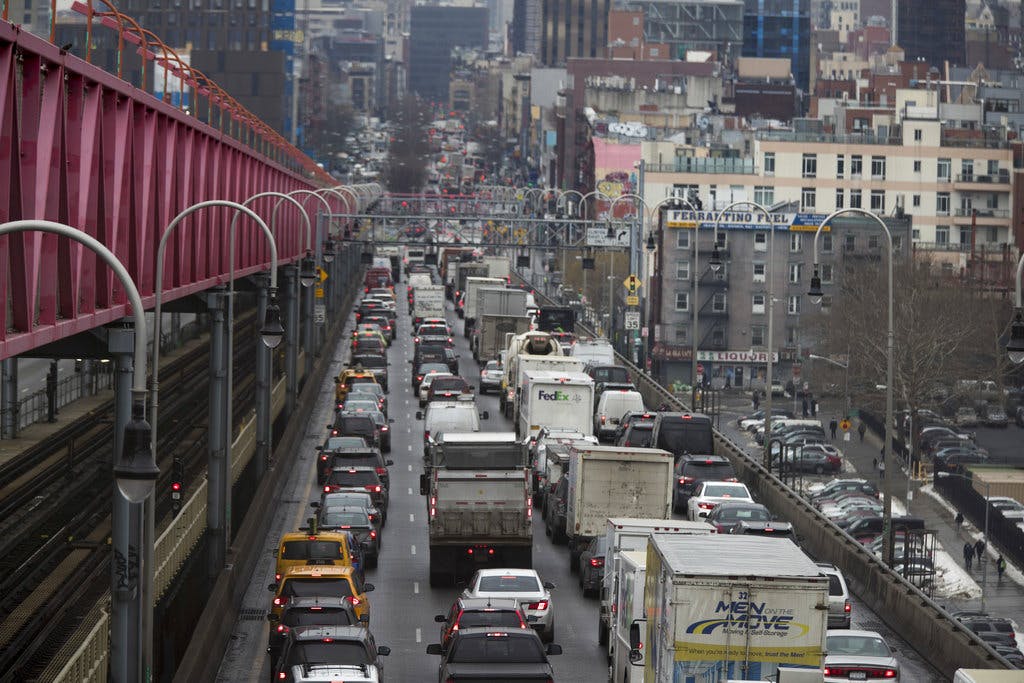New York City Commuters Brace for Congestion Pricing
The effort by New York to milk drivers for even more money — still in the planning stages — has been hit with dozens of lawsuits.

New York City rings in 2024 with plans to tax vehicles entering Manhattan’s Central Business District. America is watching to see if the first-in-the-nation program overcomes the speed bumps erected by those footing the bill and can deliver on its promises.
“As Gotham struggles to recover from Covid,” the Sun wrote in July, “it’s hard to imagine a worse idea,” than congestion pricing. The Metropolitan Transportation Authority, however, sees tolls closing a budget deficit projected to be $2.5 billion in 2025.
“Congestion pricing,” New York’s Democratic governor, Kathy Hochul, said two weeks ago, “means cleaner air, better transit, and less gridlock on New York City’s streets.” The outer boroughs, New Jersey, and Long Islanders argue that it just shifts these problems to their backyards and charges them for the privilege.
On Tuesday, the MTA announced public hearings on February 29, March 1, and March 4, but it remains on track to start collecting by the middle of 2024. The rates will be $15 for passenger vehicles, $7.50 for motorcycles, and $24 to $36 for trucks.
In July, New Jersey filed a lawsuit against the U.S. Department of Transportation to halt the plan. The Democratic mayor of Fort Lee, Mark Sokolich — whose town hosts the western entrance of the George Washington Bridge — brought a class-action lawsuit last month.
The George Washington Bridge is already the busiest in the world, with a quarter-million motorists crossing each day to enter Manhattan at W. 178th Street. Mr. Sokolich told the press that vehicles would swarm north to avoid the tax.
“We’ve had enough,” Mr. Sokolich said. “The additional traffic is secondary at this point. We deal on a daily basis with the pollutants, the soot, the filth. Additional traffic brings additional pollution.” He projected up to 25 percent more traffic flooding Fort Lee’s streets.
“We have to put our foot down to protect New Jerseyans,” the Democrat of New Jersey, Governor Murphy, said in a July press conference laying out his legal action. The Republican borough president of Staten Island, Vito Fossella, launched his own lawsuit days later.
Staten Island doesn’t have a subway link to Manhattan, Mr. Fossella said, and residents would now be “forced to pay an additional toll.” The Democratic congressman whose district includes Fort Lee, Joshua Gottheimer, said the plan would put a $5,000 annual burden on commuters.
That would be, Mr. Gottheimer said, on top of gas, parking, the $17 they pay for a bridge or tunnel, “and the billions of dollars Jersey residents pay every year to New York in income taxes.” Citing an MTA environmental analysis of how it would alter traffic patterns, he said it would result in “more congestion and more pollution.”
Mr. Murphy agreed the toll “would simply shift carbon emissions from affluent TriBeCa and Times Square into North Jersey communities.” In June, the Republican executive of New York’s Rockland County, Edward Day, also objected.
Rockland, Mr. Day said in a statement, has “the highest level of transit inequity in the MTA region.” With some points lying 45 miles from 61st street, residents live in a “transit desert that forces more than 60 percent … to drive into the city because they have no other way to get there.”
Last month, the 25,000-strong New York City Taxi Workers Alliance filed their own lawsuit, and trucking organizations signed a complaint letter with government officials, transportation associations, chambers of commerce, and businesses.
The letter cited the cost to those congestion pricing pledges to help, saying it “will increase labor costs for employers and the price of goods and services for residents.” Despite all this blowback, the MTA is feeling good about its chances.
The MTA began erecting infrastructure for tolls at 61st Street and West End Avenue in Manhattan over the summer. This will be the northern frontier of the Central Business District, which will extend south to the tip of the island.Throughout the new year, America will be watching the drama unfolding on the streets of Gotham. If the tolls succeed in raising money while improving life and air quality, expect other cash-strapped municipalities to import the idea, with commuters and businesses paying the price.

